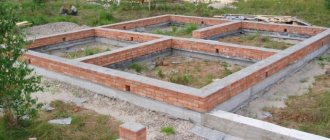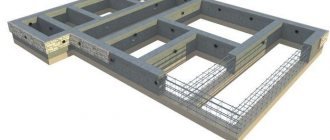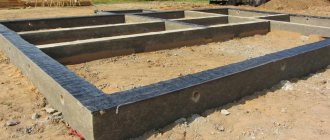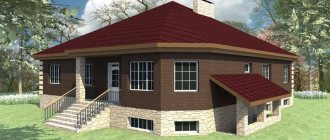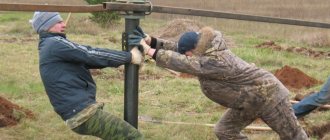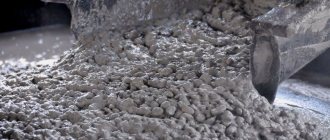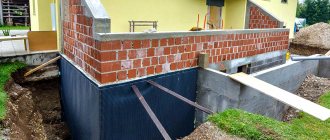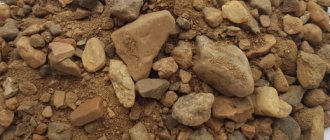The foundation is the basis of any structure, so it is extremely important to avoid even the slightest mistakes when arranging it. A well-made foundation will not only strengthen the structure, but also extend its service life. The construction of a two-story house also begins with the development of the foundation, but first you need to examine the soil for its condition and the height of the ground aquifers. Such geodetic studies are required in order to calculate what depth and height are needed for the foundation of the future house.
Types of foundation
According to the method of execution, it is divided into several types. The most common ones are:
- columnar;
- pile;
- tape;
- monolithic slab.
Private residential building
Columnar
The use of the presented type is more justified in the construction of panel townhouses, and, for example, houses made of aerated concrete or a Finnish mansion made of timber boards resting on pillars have gained popularity not only in our country, but also abroad.
The technology for constructing such a foundation boils down to installing supports along the intended perimeter of the future building. They are installed at certain intervals in pre-drilled holes. The diameter of the latter is variable.
These indicators are determined by calculating the degree of load per unit area.
Taking into account what depth is most appropriate in a particular case, builders give preference to different types of pillars. Pipes, reinforced concrete stepsons, logs, and natural stone can act as supports.

Pillars
Pile
Another type of supporting element that has become widespread in various fields of construction is the pile. Modern technology for using piles as a key component of the supporting surface is a single complex of complementary structural elements.
This engineering solution eliminates deformation of individual peripheral parts and ensures uniform distribution of force on the ground.
According to the principle of pile installation, the pile foundation is divided into hanging and retaining.

Scheme of the pile-tape design option
The first category of load-bearing supports is installed in dense soil layers, the height of which reaches several meters. Piles are driven into the ground at calculated intervals. A significant part of the load of such a support falls on its side surface, while the base plays a secondary role.
In this position, the soil under the pressure of the support walls can, as they say, “crawl.” This disadvantage is compensated for in the following ways:
- increasing the cross-section of workpieces;
- increasing the length of the pile;
- giving the shape of the pile convexities at the base and in places of lateral contact with the ground;
- increasing the density of pile installation.
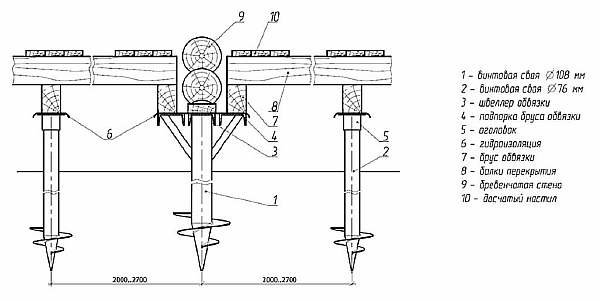
Screw pile installation diagram
Retaining piles are very different in functionality from previous models. Unlike pile and hanging supports, this type of base structure is driven to a shallow depth with a small interval between two adjacent elements. The average height of such supports is 40–70 cm. This technology is typical for 1-story frame-type buildings.
Tape
The so-called strip type of laying the foundation of a building deserves special attention. Its fundamental difference is that in the presented case they use a block type of backfill or a continuous concrete strip.
In accordance with the requirements for strength and load, the blocks can have a solid or hollow structure. Houses made of aerated concrete based on this technology are characterized by high seismic resistance and durability.
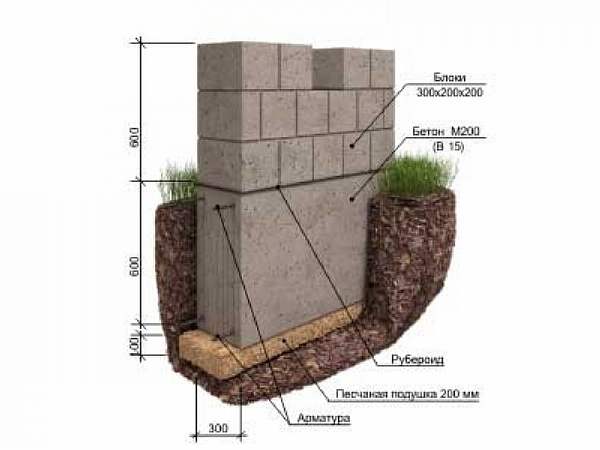
Depth drawing
Monolithic slab
Slab foundation - it is characterized by a large load-bearing area and an exceptionally high level of resistance to seismic ground vibrations.
What affects the depth and structure of the foundation
Factors that must be taken into account when laying the foundation for a two-story house:
- the quality of the soil (rocky, semi-rocky, loose), the depth of its freezing in a particular area, as well as the level of groundwater rise;
- what will be the approximate weight of the future structure, its configuration, as well as the thickness of the external walls;
- terrain landscape for future construction;
- season.

If we assume that the foundation for a one-story building is laid to a depth of at least 0.8 m, then for a building of two floors this size will be equal to 1.7 m. This conclusion is very approximate, because high-quality calculations require careful preparation, necessary research and research. Only having the conclusions of geologists and geophysicists in hand can you determine what kind of foundation will be needed to build a house and be sure that during operation the structure will not “lead”, will not warp, the walls of the house will not become covered with cracks, and the structure itself will not sag.
It is practically useless to start construction in winter; in the fall it is too late, since if you leave the building for the winter, then in the spring you will have to spend money on its resuscitation. In summer, possible intense heat will not allow the concrete to harden evenly, which will have a bad effect on its strength characteristics. But spring is the best time, just not early, rainy, but mid-April; you can have time to make not only the foundation (monolithic, pile or block), but also the entire house with a roof, windows and doors.
Thus, in a complex landscape of different heights, it may turn out that the depth of the foundation at different points of the perimeter will be different. And if the soil in a given area has the characteristics of weak and uneven, then the best solution is to build a pile foundation.
By the way, such a foundation can also be chosen by the owner in order to save money and reduce the cost of the overall estimate. But building a basement under the house with this solution is unlikely to work.
The best choice for a two-story house
Choosing the most optimal foundation installation technology is the key to trouble-free, long-lasting construction. At this stage, it is extremely important to conduct a comprehensive analysis of the features of a particular object. In this case, it is necessary to take into account the maximum permissible loads on the supporting structure.
To resolve the dilemma of which foundation is better, you should turn to statistical data. The widespread practice of using various types of foundations for a two-story brick house allows us to confidently state that strip technology in this case acts as the highest priority direction.

Manor
For example, the foundation for a two-story house made of foam blocks based on this technology has already gained popularity among many happy owners. The prerequisites for choosing the presented method are based on the optimal combination of various technical, material and operational criteria.
The advantages of this method are as follows:
- high level of load-bearing capacity;
- high performance indicators;
- resistance to deformation and tearing;
- ease of installation;
- low level of material costs;
- ease of maintenance;
- the ability to choose different types of layouts;
- minimum technical equipment.

Installation of formwork
It should be noted that all the positive aspects of the recommended technique will manifest themselves only if they strictly comply with the requirements and the availability of good-quality materials.
Foundation calculation
This procedure, as a rule, does not cause serious complications if you approach it with the proper level of responsibility. It involves collecting load data and studying the load-bearing layers of the soil. The thickness of the foundation for a two-story house will be determined depending on the ratio of these two components.
The video explains in detail how to calculate the foundation yourself.
First of all, it is necessary to conduct a thorough study of the work site. The depth of the foundation for a two-story house made of foam blocks should be 35–55 cm higher than the average freezing depth.
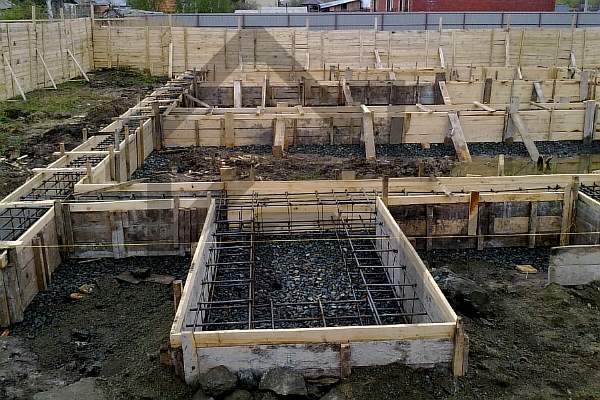
Formwork and reinforcement
Such data are acceptable only if the living space is heated in the winter. Otherwise, it is necessary to adhere to the established freezing temperature for a specific region.
The relative value of the tape width will be 25 cm. This value is approximate and will change during the calculation process.
The next step is to calculate the pressure on the strip foundation for a two-story house. To determine the appropriate value, it is advisable to use the table below.
| Construction type | Density (kg/m2) |
| Walls | |
| Brickwork (half brick) | 210–240 |
| Houses made of foam concrete | 170–180 |
| Houses made of logs (d=240 mm) | 130–145 |
| Houses made of timber (150 mm) | 11–125 |
| Floor elements | |
| Attic (wooden beams) | 10–120 |
| Hollow concrete slabs | 30–380 |
| Reinforced concrete floors | 450–520 |
| Roof | |
| Metal tiles, corrugated sheets | 25–35 |
| Two-layer roofing felt | 35–45 |
| Slate (crest height – 4 cm) | 50 |
| Snow load for the central regions of Russia | 100–120 |
The next stage is calculating the total weight of the strip slab. To do this, you must first calculate its volume, which is calculated using the product of length - L, width - A and height - B.
We multiply the resulting value by the specific gravity of reinforced concrete, which is 2500 kg/m3. The final result is the total weight. To calculate the total load - M - on the load-bearing soil layer, it is enough to add this value to the weight of the building.
What affects the width parameters?
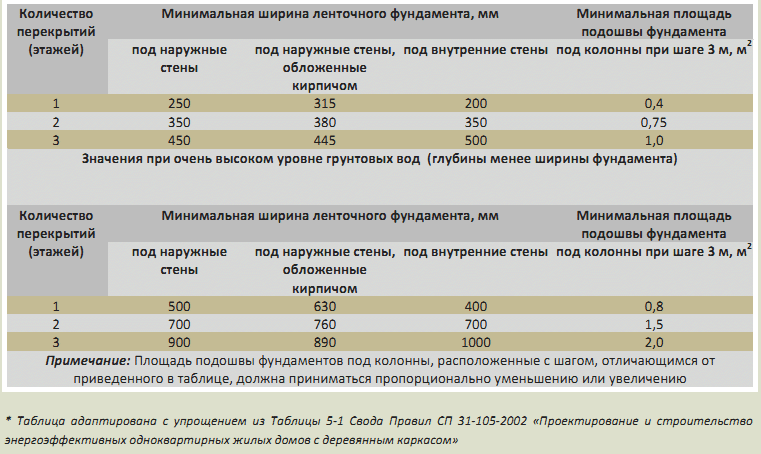
Minimum width of a strip foundation for an individual frame house.
When calculating the width of the foundation of a two-story house, it is necessary to take into account some parameters on which it depends. Among these indicators it should be noted:
- Calculation of the area of the base for the pit, which depends on the total load of the structure, that is, the total load-bearing capacity. Before you begin to calculate the width of the strip foundation, you need to determine the load-bearing capacity.
- The thickness of the load-bearing walls that will be built on the tape. Taking this parameter into account, the dimensions for the thickness of the base should be at least 100 mm greater than the thickness of the walls of the house. This value is quite enough to carry out high-quality finishing of the façade after construction is completed.
- When reinforcing the tape, not only the weight and depth of the base are taken into account, but also the correctly maintained distance between the rods (from 200 mm).
Installation of strip foundation
The sequence of actions in the case under consideration involves the following work:
- digging a trench;
- pillow placement;
- installation of block elements and pouring of concrete strip.

Tape for building
Before you start digging a trench, you need to mark out the area of the future structure and draw lines with all axes broken down. The depth of a strip monolithic foundation for a two-story house is calculated taking into account the payload of the entire building and in accordance with the results of geodetic surveys of the area.
The width of the strip reinforced foundation for a two-story house is established based on the results of the calculation data presented above.
The cushion is most often sand, gravel or concrete. The choice of material should be determined by the quality of the soil and the degree of load on the base. Sand is usually laid in one layer 150–200 mm thick. This pillow should be thoroughly moistened with water and compacted.
The photo shows a building strip.
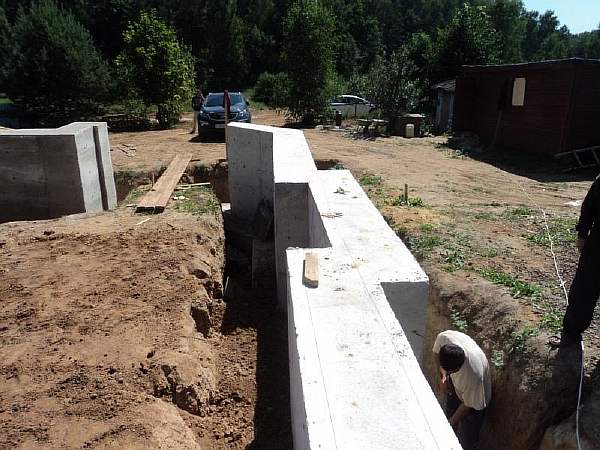
Before waterproofing
It is advisable to use a mixture of sand and gravel in the presence of soil with a high content of loose rocks. This mixture is prepared from equal shares of both ingredients.
After applying the pillow, it should also be moistened and compacted. Concrete blocks are used as a base layer in extremely unfavorable soil conditions.
Such a foundation made of blocks will eliminate the possibility of subsidence and will significantly facilitate the installation of load-bearing elements.
Installing blocks for a 2-story house does not require any special professional skills. Houses made of aerated concrete, as well as foam block and aerated concrete buildings, are built using a similar principle. The blocks are installed according to markings one to one with the ends pre-coated in the solution.

Section and section
The tape is poured in several stages. First, reinforcement is laid on a cushion poured with a thin layer of concrete. It should not come into contact with the surface of the trench and formwork.
After this, the cavities of the reinforced structure are poured with a concrete solution of medium viscosity until the bottom layer is completely filled. And finally, the final stage involves filling the base part and setting the zero mark.
Once the above work has been completed, it is essential to ensure the correct level of insulation. Houses made of timber and foam concrete need it more.
Formwork and reinforcement
Installation of formwork is carried out using wooden panels, boards or flat sheets of slate.
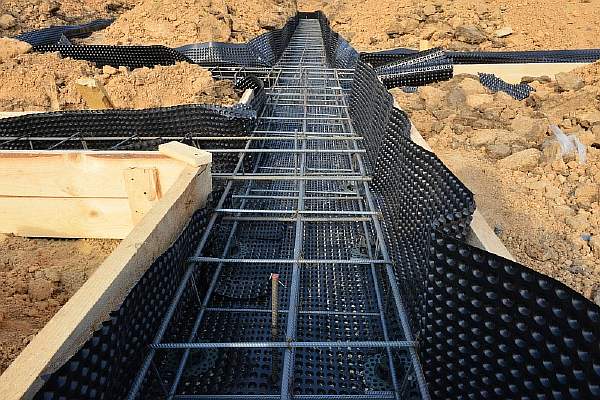
Membrane in formwork
This event involves a strict sequence of the following operations:
- Before proceeding with the installation of individual sections of the formwork, it is necessary to mark the area to visually determine the contours of the above-ground part of the base structure. As a rule, posts/pins are installed in the corners through which the thread is passed. For such pins, cut reinforcement is ideal. Thus, the thread will serve as a guide for installing the formwork, determining the dimensions of the foundation and indicating the base of the base.
- For ease of installation, boards or other working material are best mounted in the form of prefabricated panels. The panels are plumb and attached to wooden supports using self-tapping screws or nails.
- Before the shields take their place, it is necessary to take care of the openings for various communications and vents. To do this, appropriate slots are first made in the panel elements of the formwork.
- To give the structure greater rigidity, the shields should be strengthened with transverse bars. The frequency of use of such reinforcing elements is determined individually for each individual type of formwork.
- An integral part of the strip structure is the reinforcement. Its purpose is difficult to overestimate, because it is it that creates a strong frame for the entire load-bearing part as a whole.
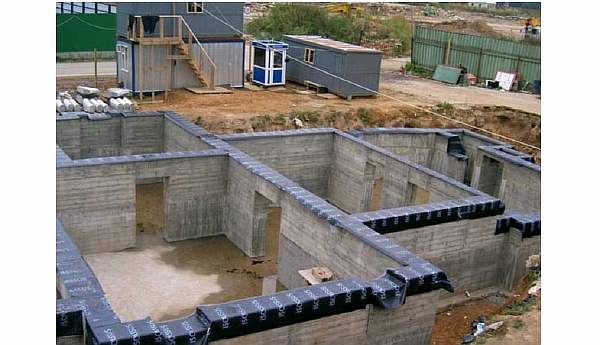
Ground floor basement
To reinforce the strip base, rods with a diameter of 12 to 16 mm are used. For tying reinforcement, soft steel wire is used. Unlike a welded contact, such a connection gives the entire structure flexibility and ductility.
